There are more than 1,000 species of the succulent peperomia. These evergreens range from ground-dwelling vines to upright shrubby plants that rarely surpass 12 inches tall. Peperomia plants are commonly cultivated indoors in small pots, but they also grow outside. Plants in the Peperomia genus can look so different from one to the next that it’s difficult to discern if they are even related. All Peperomia plants are low maintenance, slow-growing, and can be planted all year long.
Native to tropical areas like southern Florida and South & Central America, Peperomia plants can be found on the forest floor, making them tolerant of lower light conditions. The species vary in appearance, though many feature leaves that are rounded and slightly thick. And while many peperomia plants have bright green leaves, the foliage can come in different colors, textures, and patterns. In general, they make for slow-growing and low-maintenance plants. You typically can plant them anytime as houseplants, though planting at the start of the growing season in the spring is ideal.
- Peperomia Argyreia
- Peperomia Obtusifolia
- Peperomia Orba
- Peperomia Ferreyrae
- ‘Hope’ Peperomia
- Peperomia ‘Ruby Cascade’
- Peperomia Tetragona
- Peperomia Graveolens
- Peperomia Clusiifolia
- Peperomia Caperata
- Peperomia Albovittata
- Peperomia Rubella
- Peperomia Axillaris
- Peperomia Perciliata
- Peperomia Incana
- Peperomia Quadrangularis
- Peperomia Prostrata
- Peperomia Serpens
- Peperomia Dolabriformis
- Peperomia Rotundifolia
- Peperomia Verschaffeltii
- Peperomia Kimnachii
- Peperomia Verticillata
- Peperomia Polybotrya
- Peperomia Elongata
- Peperomia Nivalis
- Peperomia Maculosa
- Peperomia Columella
- Peperomia Metallica
- Peperomia pellucida
- Peperomia Glabella
- Peperomia fraseri
Watermelon peperomia

Watermelon peperomia (Peperomia argyreia) plant is not closely related to either watermelons or begonias. These terms relate to the shape, markings and texture of the leaves. Growing to 20 cm (7.9 in) tall and broad, it is a perennial with asymmetrical oval green leaves, slightly fleshy, strikingly marked with curved silver stripes, and red stems. Tiny green flower spikes appear in summer. Watermelon peperomia is well suited for planting in containers or hanging baskets.
Peperomia obtusifolia

Peperomia obtusifolia, also known as the baby rubberplant, American rubber plant, or pepper face is characterized by its thick, upright stems with glossy, spoon-shaped leaves, which store water. In its natural habit, the plants leaves will shrivel in drought and plump after it rains. The leaves are typically a vibrant green but can also have white-and-green variegation that resembles marbling.
Also Read: Different Types of Calathea Plants
Peperomia Orba

Peperomia Orba also referred to as teardrop peperomia grows slow and stays compact, reaching a height of 6″ inches at maturity. Its growth accelerates during the spring and summer months and slows down during cooler times of the year. Tiny, thickened, leathery, and shiny leaves 1 to 2 inches long are densely lined up on fleshy, red, trailing stems. In mid-summer, mature teardrop peperomia blooms with tiny, only one-inch large greenish piston-like and not particularly interesting flowers.
Peperomia Ferreyrae
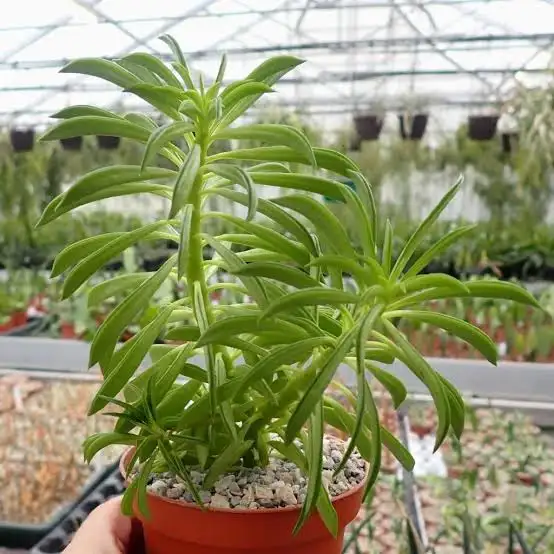
Commonly known by the names Happy Bean Plant and Pincushion Peperomia, amongst others. Peperomia Ferreyrae is small in size. Because it stays compact, it is the perfect succulent to place on your desk, bookshelf, windowsill, or any other decorative space in your house or office. Whorled kind of peapod shaped leaves that are narrowly windowed near the length of the top grow along thick and sometimes tall semi – succulent stems. Stems become tall when the plant matures. The plant grows upright and kind of bushy.
Peperomia Hope

Peperomia ‘Hope’ is a hybrid of Peperomia deppeana and Peperomia quadrifolia. The botanical name for peperomia ‘Hope’ is Peperomia tetraphylla ‘Hope’. Its thick foliage grows on a long trailing vine, and is coin shaped and bright green with faint light green stripes. Peperomia Hope will not flower, but its attractive foliage makes up for the lack of flowers. Like other trailing vines, it can be trained up walls, across ceilings, or around stair rails. The young vines will first grow up, and then with time, flop over and begin to trail. This perennial epiphyte is an ideal hanging basket plant because of its compact growth, trailing stems and evergreen foliage.
Peperomia ruby cascade

Peperomia ruby cascade is a vining plant with distinctive ruby-red leaves. The most striking feature of peperomia ruby cascade is the two-color leaves. The top surface is a deep, glossy dark green, while the underside of maturing plants leaves are a rich ruby color. The stems can grow several feet in length. Some plants will produce small, pinkish flowers in the spring. However, these plants are not known for frequent flowering. It is a rewarding plant that makes a dramatic statement in a hanging basket with long vines of green and red leaves trailing to the floor.
Also Read: Different Types of Alocasia Plants
Peperomia Tetragona
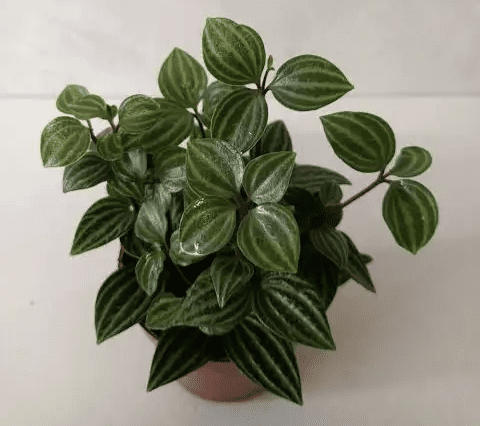
Formerly classified as Peperomia puteolata, and also by the common name “Stilt Peperomia”, this strikingly-striped peperomia has a different growth habit than most of the others. This unique peperomia produces long shoots which will then form a rosette of new leaves that make the tall shoot top-heavy, causing the newly formed leaves to lean over onto a nearby growing surface where it would root and then begin the process all over again. Though, as the plant matures this gorgeous Peperomias stems will grow longer and trail, adding to their appeal as architectural hanging specimens.
Peperomia Graveolens

Peperomia Graveolens has a shrub-like growing habit with new branches shooting out of the main stem. The plant can grow to approximately 20cm height and 15 in width.The thick ruby red stem and red and green chunky leaves of this succulent plant are waxy and bright. The leaves are roughly 2-3 cm long and look as if they are about to fold right down the middle. The underside of the leaf is wine read and glossy. The top side is green and makes a beautiful contrast to the stem. The flowers appear mainly in spring and are slightly strange. The thin flower spike does not look like a flower at all. It grows out of the centre of each branch and is composed of many tiny little flowers.
Peperomia Clusiifolia
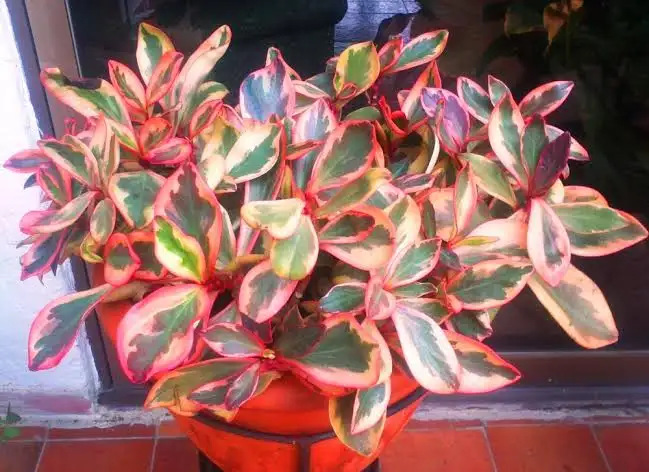
The Peperomia Clusiifolia has all-natural characteristics of a typical tropical plant as it belongs to the Peperomia genus. Also referred to as Jelly Peperomia produces oval-shaped leaves that come to a point at the ends. The succulent leaves are often light green with darker green coloring in the center and red or pink edges. This compact plant typically only grows to about 6″ or 7″ inches. Healthy plants produce white panicle-like spikes appearing in the spring. The spikes almost resemble white worms reaching toward the sky and don’t produce a noticeable scent.
Peperomia Caperata

Peperomia caperata also referred to as the emerald ripple peperomia, this compact plant has short stems covered by heart-shaped, deeply ridged leaves. The leaves are green, sometimes with a blush of red, and dark green veins. In summer through early fall, you may see slender flower spikes. They rise tall above the mound of foliage, growing from the base of the plant with reddish-purple stems. Whether you like the “flowers” or not…they are one of the hallmarks of Peperomia caperata.
Peperomia Albovittata

Also referred to as Piccolo Banda or Ivy Leaf Peperomia has very pale, thick, silvery green round medium-sized leaves marked by heavy veining in shades of deep green or purple running in bands the length of the leaves. The red stems of the Peperomia albovittata are succulent and fleshy. The slow-growing Peperomia albovittata plant attains a height of 8” -12” inches, not counting the flower spikes.The Peperomia Albovittata prefers its soil to be loamy, with a mixture of charcoal, worm compost, orchid bark, and coco fiber. The Peperomia Albovittata also prefers humidity levels of up to 50% since this helps them retain the water in their succulent leaves. Another requirement is the average indoor temperature of about 68 to 86 degrees Fahrenheit (20-30 degrees Celsius).
Also Read: Different Types of Begonia Plants
Peperomia Rubella
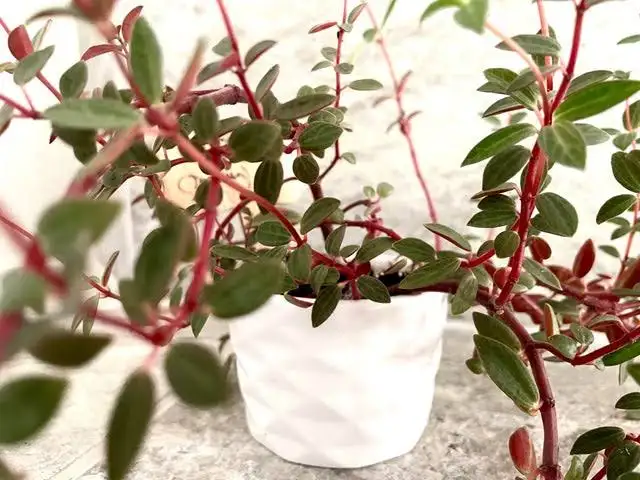
The Peperomia Rubella plant is small, it makes a great house plant. It has small green leaves and throws out runners from the base of the stem to grow wide. As a result, the plant reaches 4-6″ tall, and then falls over like a vine. It continues to grow as long as the environment will allow. Rubella Peperomia produces small, greenish-white flower spikes in the summer. The spikes tend to look like tentacles sticking out of the plant’s leaves and do not have a fragrance. Due to its natural vining tendencies, Rubella Peperomia grows best in a hanging basket. Baskets allow Rubella to display the red hues from the foliage’s underside.
Peperomia axillaris

Peperomia axillaris is a beautiful succulent belonging to the Piperaceae botanical family. The plant has an erect habit and branches. The stem is woody and covered by the alternately arranged leaves. The leaves are fleshy, thick, small, lanceolate, bright green in color. The leaves store water and then use it during drought periods. The leaves are composed of window tissue a transparent tissue extending from the epidermis down into the leaf which allows light penetration to the interior photosynthetic tissue. Blooming occurs during the spring and buds are borne at the top of the stem. The flowers are tiny, tail-like and light green in color.
Peperomia perciliata
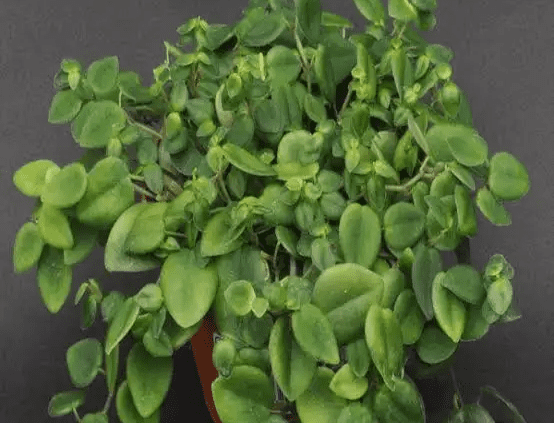
Peperomia perciliata, sometimes called Peperomia fagerlindii. The leaves are oval shaped and dark green. The stems are red and trail along the soil or will hang over the edge of the pot. It has a real tight growth habit and branches freely. This is definitely a daintier Peperomia that works beautifully in a terrarium, and is also great in a hanging pot since it is a trailer.
Peperomia incana
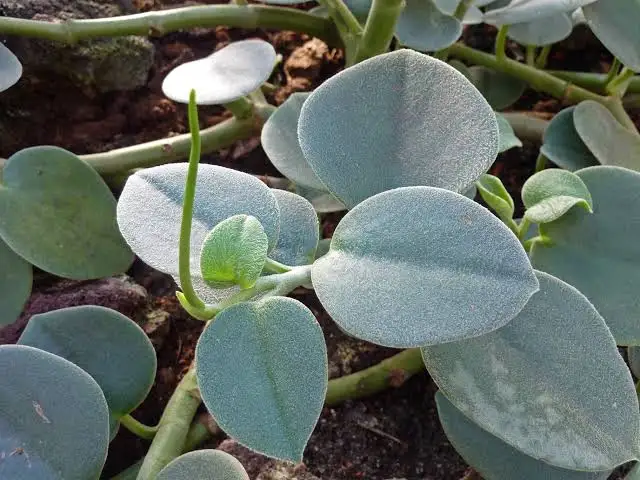
Peperomia Incana is a slow-growing fuzzy peperomia that thrives in bright direct and indirect sunlight. Incana grows velvety heart-shaped leaves along heavy stems that store water, similar to plants in the succulent family. The fine hairs that cover the leaves and stem protect it from sun damage, and also give it a felted appearance. It will typically reach between 6″ to 12″ inches in height. It will also spread to between 12″ and 15″ inches in width. This plant is tolerant of underwatering, but over watering will cause the plant to drop leaves. Leaves will get thin and flexible when this plant is thirsty; do not water unless the leaves indicate it needs water.
Also Read: Different Types of Anthurium Plants
Peperomia quadrangularis
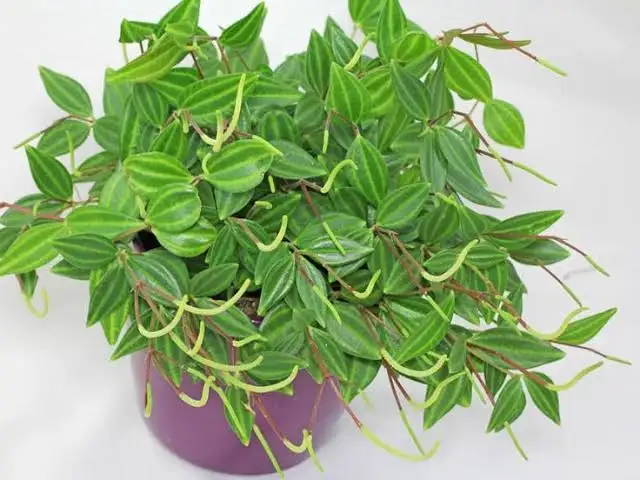
Peperomia quadrangularis is a small trailing peperomia with leaves that are ovate, dark green and they have golden veins. The leaves are quite stiff but the stems are very thin and flexible. This peperomia will make a very nice small hanging basket. It also does well in a terrarium as a small creeping ground cover. This plant is the same as Peperomia angulata, this older name is is still sometimes used and it is also known by the names Radiator Plant and Peperomia Beetle.
Peperomia Prostrata
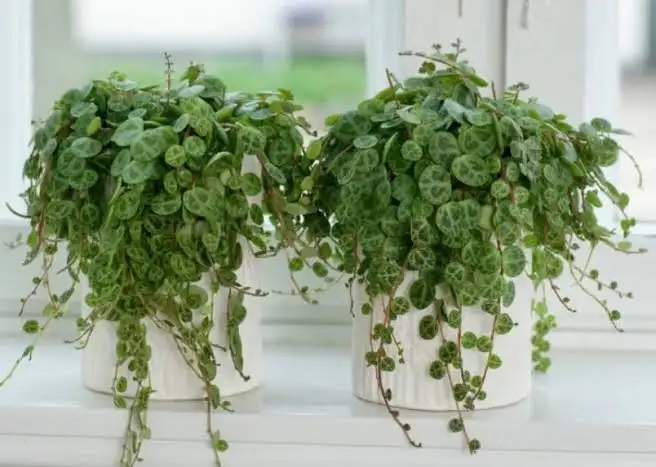
Peperomia Prostrata is a miniature peperomia plant with tiny, fleshy, succulent leaves, only one-fourth of an inch wide that resemble turtle shells. The leaves are tiny, dark green with a beautiful pattern of white veins, which range in color from maroon, to dark blue to purple, on young new growth, and turn silvery-white as the leaves age. The height of the plant is approximately 1″ inch to 4″ inches, and its width is approximately 4″ inches. When potted, this vining plant may form a thick mat and cascade over the sides of the container.
Peperomia serpens
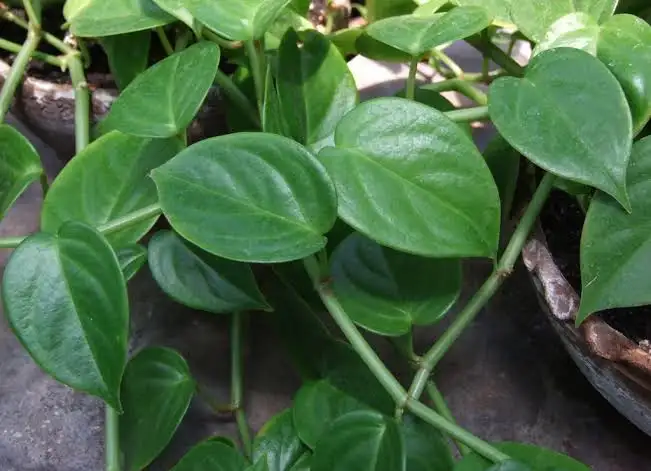
Peperomia serpens is a charming perennial reminiscent of a miniature ivy with laid or hanging shoots. In nature, the vining peperomia grows like an epiphyte, and its stems, sprinkled with pointed heart-shaped leaves, hang freely along with the trees. The cordate, shiny leaves most often have a pure fresh green color, although there are cultivars with variegated foliage in a combination of green and cream white. The leaves are densely strung on stems that can grow up to 2 feet, so the plant is often grown in hanging baskets.
Peperomia dolabriformis

Peperomia dolabriformis also known as Prayer Peperomia, is a curious shrubby perennial, with stems becoming woody with age. The plant has thick, green succulent foliage. The shape of the foliage resembles pea pods or small purses. They are lime green and appear folded in half. The top of each leaf has a dark green translucent stripe along the fold, helping the foliage absorb more light. The leaves may form a rosette or a loose branch. Over time, the Prayer Pepper develops a dense cluster of the purse-like leaves, reaching 14″ to 28″ inches tall.
Also Read: Popular Varieties of Black-eyed Susan
Peperomia Rotundifolia

Peperomia Rotundifolia or the Jade necklace is a trailing plant is an evergreen perennial with long soft stems produce many small rounded leaves along the stems that may intertwine and weave in and out of each other. The round leaves are quite thick and soft succulent. Trailing jade can produce small flowers on spikes, however, they are non-showy and the main attraction is the trailing stems and leaves. These plants are ideal for hanging baskets and windowsills. Peperomia rotundifolia is non-toxic to cats and dogs.
Peperomia verschaffeltii
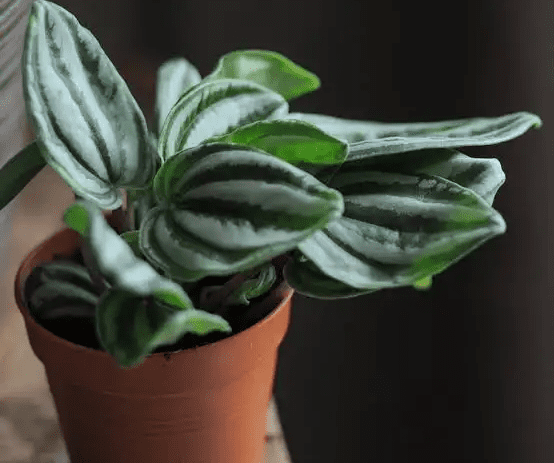
Peperomia verschaffeltii as known as “Mini Watermelon Peperomia”. The plant is named watermelon for its similarity of appearance to the rind (skin) of a watermelon. This peperomia remains quite compact, growing in small mounds rather than on long petioles. The ovate leaves are deep green along the veins and shimmery silver between. The leaves can be either flat and open or curled up making them quite unique.
Also Read: Different Types of Jade Plants
Peperomia kimnachii
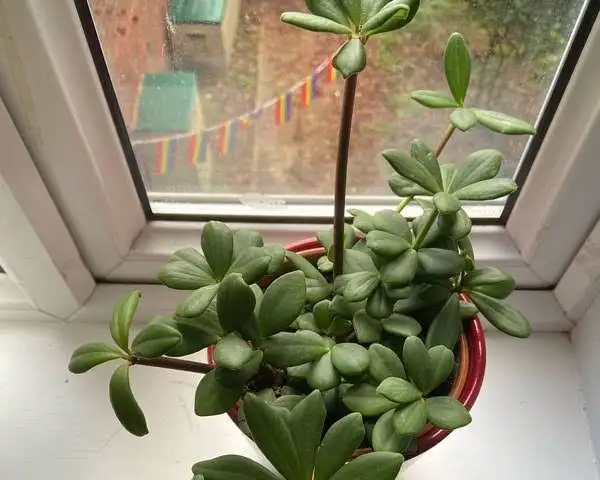
Peperomia kimnachii is an unusual succulent perennial species that originates from Bolivia, it produces oval leaves with pointed tips in radial whorl-like clusters around red stems. The leaves are spaced out at distances of around 10-15cm, stems do not branch much but grow outward and upward, up to 90cm long, these tend to droop under their weight and end up hanging pendulously. Flowers rarely, when they appear, they are small and coloured white, arranged in a spike that resembles a rats tail or an aroid flower spadix. They are typically 12-25cm in length and the flowers have a powerful, musty scent.
Peperomia verticillata
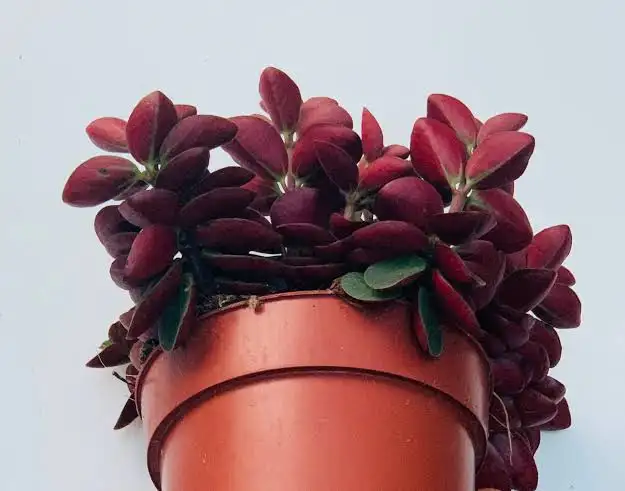
Peperomia verticillata, also known as Red Log Plant, is an evergreen succulent plant featuring plump and cupped leaves with red wine-colored undersides, carried on trailing stems. The stems appear upright at first, but eventually spill over do to their own weight. Displays inconspicuous greenish white, panicle-like flowers. Plant in a container or hanging basket indoors or use as a summer patio plant.
Peperomia polybotrya
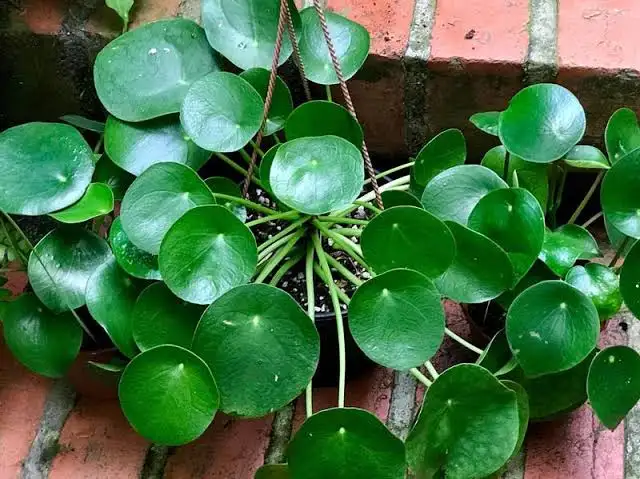
Peperomia polybotrya, also known as Coin-Leaf Peperomia or Raindrop Peperomia, is a delightful addition to your houseplant collection. The coin-leaf peperomia has succulent raindrop shaped leaves and stems allowing Polybotrya to store water through the dryer seasons. The leaves are thick, shiny, and heart-shaped with a glossy dark green sheen and pale green underneath. The coin-leaf peperomia doesn’t get very big. With proper care, it may achieve a size of at least one foot. The coin-leaf peperomia produces interesting flowers resembling green-tipped mouse tails. They grow in clusters from the tops of the stems.
Also Read: Types of Succulents For Your Home Garden
Peperomia nivalis
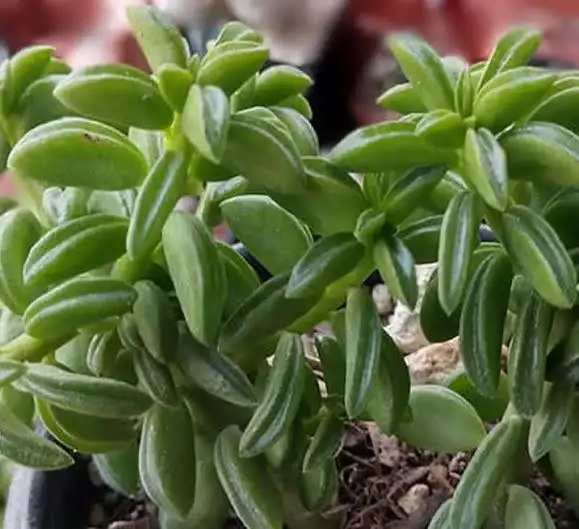
Peperomia nivalis is a beautiful succulent with boat-shaped leaves which originates from Peru, Ecuador, and other nearby regions. This unique-looking succulent plant has anise-scented sap in its stem and grows upright or crawling. Even though Peperomia nivalis looks very beautiful, it is easy to grow so long as it is growing in the right conditions. Peperomia nivalis is a perfect plant for your desktop and dish gardens because of its size, shape, and color.
Peperomia maculosa

Peperomia maculosa, commonly known as spotted-stalked peperomia and spotted peperomia is a visually conspicuous species with glossy large white-veined dark-green leaves that are attached to spotted petioles. The large leaves can be 15 cm or more in length and their underside is of a pale green colour. The stems are one to two cm thick, swelling at where petioles branch out. The petioles can be 15 to 20 cm long, covered in fine hair, light green spottet with purplish-brown, and grooved on the top side. The flower spikes are solitary and purplish in color.
Also Read: Different Types of Cactus For Indoor And Outdoor Spaces
Peperomia columella
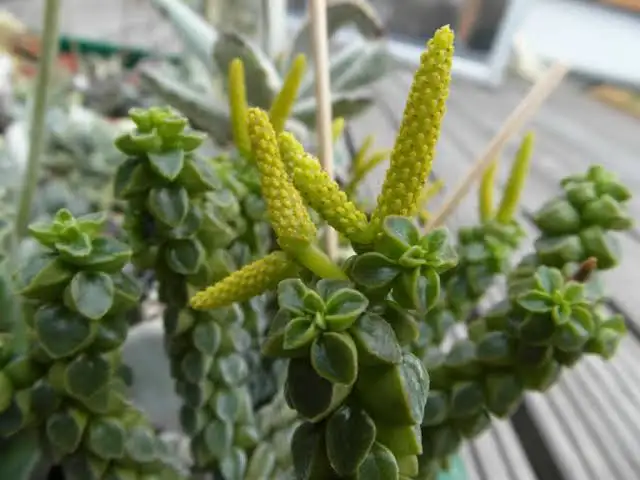
Peperomia columella is a beautiful succulent belonging to the Piperaceae botanical family. The plant has an erect habit and branches. The stem is covered by the alternately arranged leaves. The leaves are fleshy, thick, arranged in five spiral lines, shaped like a horseshoe, bright green in color. The leaves store water and then use it during drought periods. The leaves are composed of window tissue a transparent tissue extending from the epidermis down into the leaf which allows light penetration to the interior photosynthetic tissue. Blooming occurs during the spring and buds are borne at the top of the stem. The flowers are tiny, tail-like and light green in color.
Peperomia Metallica

Peperomia Metallica is an evergreen succulent plant featuring plump, leathery, cupped leaves with greenish black leaves, center silver streaks and red wine-colored undersides. The trailing stems appear upright at first, but eventually spill over do to their own weight. Displays small, creamy yellow, mouse-tail blooms in late summer to fall. Plant in a container or hanging basket indoors or use as a summer patio plant.
Peperomia pellucida
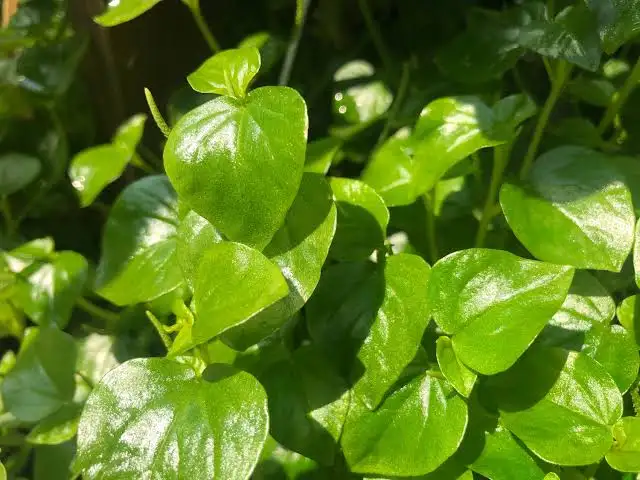
Peperomia pellucida (also known by common names pepper elder, shining bush plant, and man to man) is an annual, shallow-rooted herb, usually growing to a height of about 15 to 45 cm (6 to 18 inches), it is characterized by succulent stems, shiny, heart-shaped, fleshy leaves and tiny, dot-like seeds attached to several fruiting spikes. It has a mustard-like odor when crushed. Flowering year-round, the plant is found in various shaded, damp habitats all over Asia and the Americas. It grows in clumps, thriving in loose, humid soils and a tropical to subtropical climate.
Peperomia fraseri
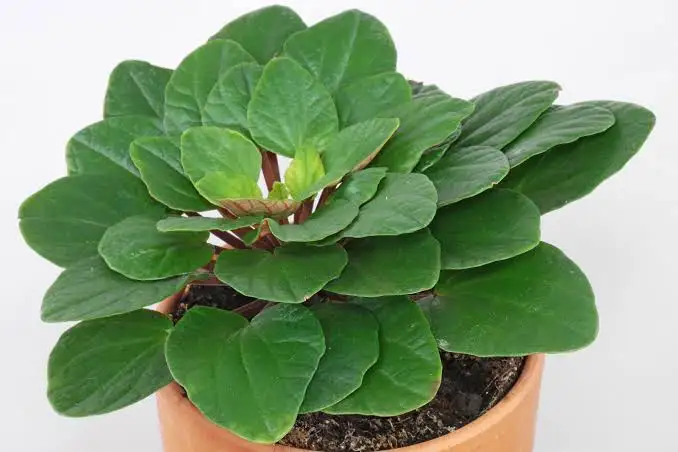
Peperomia fraseri, commonly known as the flowering pepper is a small shrub with upright stems carrying rounded or heart-shaped glossy green leaves with incised venation. It is rare among Peperomias, which mostly carry rather unremarkable tail-like flower spikes, in that it has more noticeable inflorescence: a reddish peduncle with subtly fragrant white bottle-brush flowers. The Frasieri requires the care of a typical semi-succulent Peperomia. It’s a large upright variety that can reach a foot and a half tall